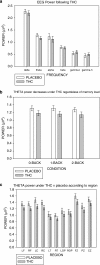Disruption of frontal θ coherence by Δ9-tetrahydrocannabinol is associated with positive psychotic symptoms
- PMID: 21150914
- PMCID: PMC3055738
- DOI: 10.1038/npp.2010.222
Disruption of frontal θ coherence by Δ9-tetrahydrocannabinol is associated with positive psychotic symptoms
Abstract
The main ingredient in cannabis, Δ(9)-tetrahydrocannabinol (THC), can elicit acute psychotic reactions in healthy individuals and precipitate relapse in schizophrenic patients. However, the neural mechanism of this is unknown. We tested the hypothesis that THC psychopathology is related to changes in electroencephalography (EEG) power or inter-regional coherence. In a within-subjects design, participants (n=16) were given intravenous THC (1.25 mg) or placebo under double-blind conditions, during EEG recordings. Using fast-Fourier transform, EEG data were analyzed for power and coherence in the delta (1-3.5 Hz), theta (3.5-7 Hz), alpha (8-13 Hz), beta (14-25 Hz), low-gamma (30-40 Hz), and high-gamma (60-70 Hz) bands during engagement in the n-back test of working memory (WM). Compared with placebo, THC evoked positive and negative psychotic symptoms, as measured by the positive and negative syndrome scale (p<0.001) and slowed WM performance (p<0.05). Under THC, theta power was specifically reduced, (p<0.001) regardless of WM load; however, the reduction showed no relationship with psychotic symptoms or WM impairment. Coherence between bi-frontal electrodes in the theta band was also reduced by THC (p<0.05) and these reductions correlated with the change-in positive psychotic symptoms (rho=0.79, p<0.001). Bi-frontal specificity was suggested by the absence of a relationship between psychotic symptoms and fronto-parietal coherence. The results reveal that the pro-psychotic effects of THC might be related to impaired network dynamics with impaired communication between the right and left frontal lobes.
Figures






References
-
- Arseneault L, Cannon M, Witton J, Murray RM. Causal association between cannabis and psychosis: examination of the evidence. Br J Psychiatry. 2004;184:110–117. - PubMed
-
- Bocker KB, Hunault CC, Gerritsen J, Kruidenier M, Mensinga TT, Kenemans JL. Cannabinoid modulations of resting state EEG theta power and working memory are correlated in humans. J Cogn Neurosci. 2010;22:1906–1916. - PubMed
-
- Buzsaki G. Rhythms of The Brain. Oxford University Press: New York; 2006.
Publication types
MeSH terms
Substances
Grants and funding
LinkOut - more resources
Full Text Sources

